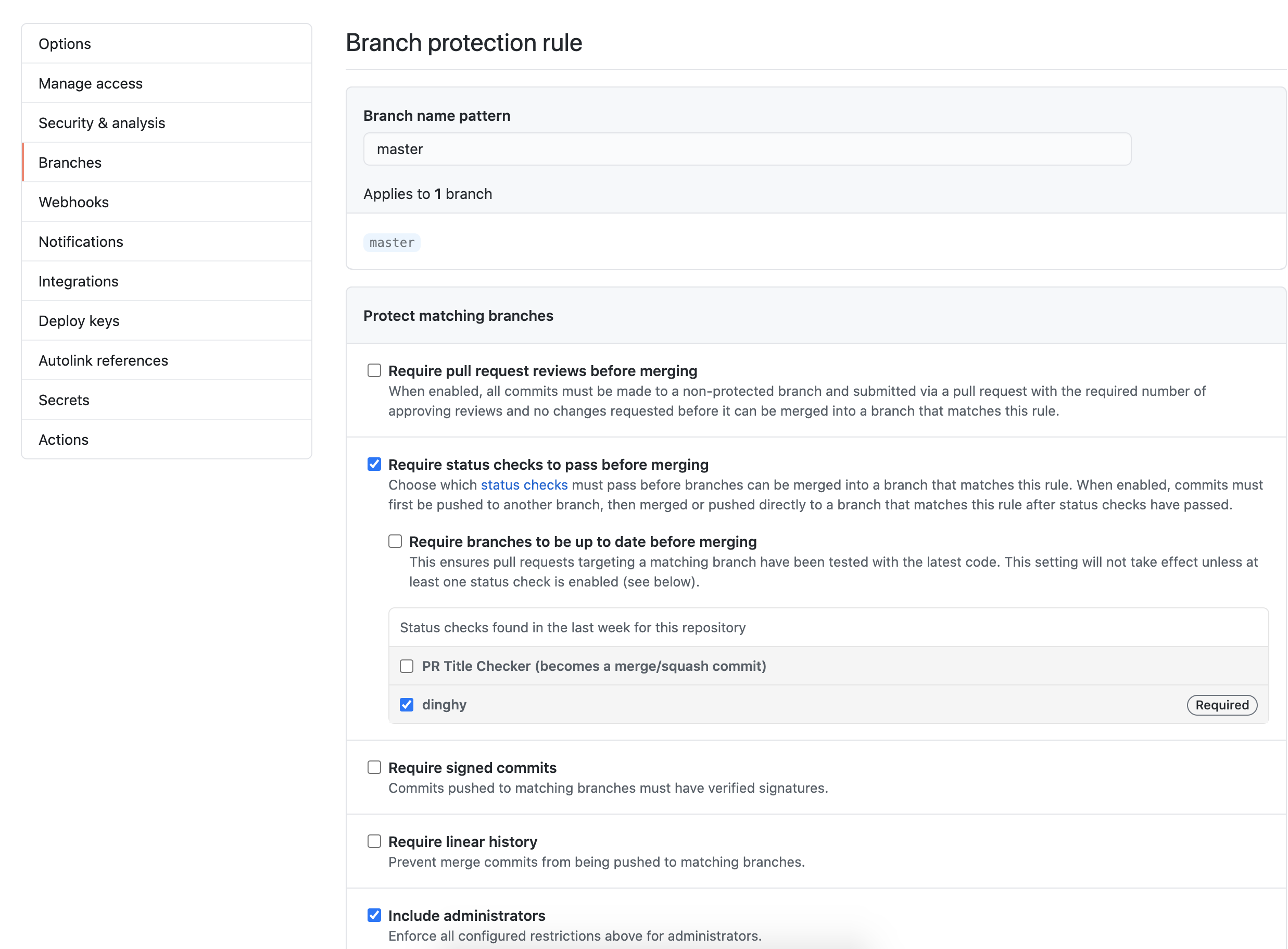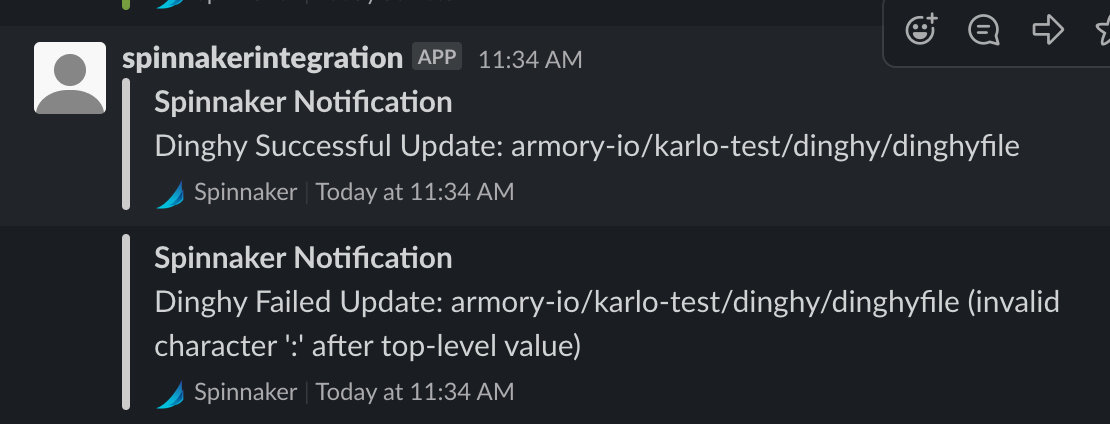Installing Pipelines as Code
This guide includes:
- Configurations for enabling Armory’s Pipelines as code feature using Spinnaker Operator or Halyard
- Settings for GitHub, GitLab, or Bitbucket/Stash webhooks to work with the Pipelines as code
Overview
To get an overview of Pipelines as code, check out the user guide.
Enabling Pipelines as code
To configure Pipelines as code, start by enabling it:
Operator
In SpinnakerService manifest:
apiVersion: spinnaker.armory.io/v1alpha2
kind: SpinnakerService
metadata:
name: spinnaker
spec:
spinnakerConfig:
config:
armory:
dinghy:
enabled: true # Whether or not dinghy is enabled
... # Rest of config omitted for brevity
Assuming Spinnaker lives in the spinnaker namespace:
kubectl -n spinnaker apply -f spinnakerservice.yml
Halyard
hal armory dinghy enable
Dinghy is the microservice for Pipelines as code.
Redis
Dinghy uses Redis to store relationships between pipeline templates and pipeline dinghy files. An external Redis instance is highly recommended for production use. If Redis becomes unavailable, dinghy files will need to be updated in order to repopulate Redis with the relationships.
Note: Dinghy can only be configured to use a password with the default Redis user.
To set/override the Spinnaker Redis settings do the following:
Operator
In SpinnakerService manifest:
apiVersion: spinnaker.armory.io/v1alpha2
kind: SpinnakerService
metadata:
name: spinnaker
spec:
spinnakerConfig:
profiles:
dinghy:
redis:
baseUrl: "redis://spin-redis:6379"
password: "password"
kubectl -n spinnaker apply -f spinnakerservice.yml
Halyard
Edit the ~/.hal/default/profiles/dinghy-local.yml file and add the following:
redis:
baseUrl: "redis://spin-redis:6379"
password: "password"
Then run hal deploy apply to deploy the changes.
Steps to follow to configure Pipelines as code:
-
Create a personal access token (in either GitHub or Bitbucket/Stash) that has read access to all repos where
dinghyfiles andmodules reside. -
Get your Github, GitLab or Bitbucket/Stash “org” where the app repos and templates reside. For example if your repo is
armory-io/dinghy-templates, yourtemplate-orgwould bearmory-io. -
Get the name of the repo containing modules. . For example if your repo is
armory-io/dinghy-templates, yourtemplate-repowould bedinghy-templates.
GitHub Example
Operator
apiVersion: spinnaker.armory.io/v1alpha2
kind: SpinnakerService
metadata:
name: spinnaker
spec:
spinnakerConfig:
config:
armory:
dinghy:
enabled: true # Whether or not Dinghy is enabled
templateOrg: my-org # SCM organization or namespace where application and template repositories are located
templateRepo: dinghy-templates # SCM repository where module templates are located
githubToken: abc # GitHub token. This field supports "encrypted" field references (https://docs.armory.io/spinnaker-install-admin-guides/secrets/)
githubEndpoint: https://api.github.com # (Default: https://api.github.com) Github API endpoint. Useful if you’re using Github Enterprise
... # Rest of config omitted for brevity
kubectl -n spinnaker apply -f spinnakerservice.yml
Halyard
hal armory dinghy edit \
--template-org "armory-io" \
--template-repo "dinghy-templates" \
--github-token "your_token/password"
# For Github enterprise, you may customize the endpoint:
--github-endpoint "https://your-endpoint-here.com/api/v3"
hal deploy apply
Configure GitHub webhooks
Set up webhooks at the organization level for Push events. You can do this by going to: https://github.com/organizations/your_org_here/settings/hooks:
- Set
content-typetoapplication/json. - Set the
Payload URLto your Gate URL. Depending on whether you configured Gate to use its own DNS name or a path on the same DNS name as Deck, the URL follows one of the following formats:
https://<your-gate-url>/webhooks/git/github(if you have a separate DNS name or port for Gate)https://<your-spinnaker-url>/api/v1/webhooks/git/github(if you’re using a different path for Gate)
If your gate endpoint is protected by a firewall, you’ll need to configure your firewall to allow inbound webhooks from Github’s IP addresses. You can find their IPs here: , you can read Github’s docs here.
Pull Request Validations
New feature
Pull Request Validation is a new feature in Armory Spinnaker 2.21.When you make a GitHub Pull Request (PR) and there is a change in a dinghyfile, Pipelines as Code automatically performs a validation for that dinghyfile. It also updates the Github status accordingly. If the validation fails, it displays an error:
The following image shows what a user sees if their PR fails the validation:

Make PR Validations mandatory to ensure users only merge working dinghyfiles.
Mandatory PR validation
Perform the following steps:
- Go to your GitHub repository.
- Click on Settings > Branches.
- In Branch protection rules, select Add rule.
- Add
masterin Branch name pattern so that the rule gets enforced on themasterbranch. Note that if this is a brand new repository with no commits, the “dinghy” option does not appear. You must first create adinghyfilein any branch. - Select Require status checks to pass before merging and make dinghy required. Armory recommends selecting Include administrators as well so that all PRs get validated, regardless of user.
The following screenshot shows what your GitHub settings should resemble:

Bitbucket / Stash Example
Operator
apiVersion: spinnaker.armory.io/v1alpha2
kind: SpinnakerService
metadata:
name: spinnaker
spec:
spinnakerConfig:
config:
armory:
dinghy:
enabled: true # Whether or not dinghy is enabled
templateOrg: my-org # SCM organization or namespace where application and template repositories are located
templateRepo: dinghy-templates # SCM repository where module templates are located
stashUsername: stash_user # Stash username
stashToken: abc # Stash token. This field supports "encrypted" field references (https://docs.armory.io/spinnaker-install-admin-guides/secrets/)
stashEndpoint: https://my-endpoint # Stash API endpoint. If you're using Bitbucket Server, update the endpoint to include the api e.g. https://your-endpoint-here.com/rest/api/1.0
... # Rest of config omitted for brevity
kubectl -n spinnaker apply -f spinnakerservice.yml
Halyard
hal armory dinghy edit \
--template-org "armory-io" \
--template-repo "dinghy-templates" \
--stash-token "your_token/password" \
--stash-username "stash_user" \
--stash-endpoint "https://your-endpoint-here.com"
hal deploy apply
Note: If you’re using Bitbucket Server, update the endpoint to include the api e.g. --stash-endpoint https://your-endpoint-here.com/rest/api/1.0
You’ll need to setup webhooks for each project that has the dinghyfile or module separately. Make the webhook POST to: https://spinnaker.your-company.com:8084/webhooks/git/stash. If you’re using stash <v3.11.6, you’ll need to install the following webhook plugin to be able to setup webhooks.
GitLab Example
Operator
apiVersion: spinnaker.armory.io/v1alpha2
kind: SpinnakerService
metadata:
name: spinnaker
spec:
spinnakerConfig:
config:
armory:
dinghy:
enabled: true # Whether or not dinghy is enabled
templateOrg: my-org # SCM organization or namespace where application and template repositories are located
templateRepo: dinghy-templates # SCM repository where module templates are located
gitlabToken: abc # GitLab token. This field supports "encrypted" field references (https://docs.armory.io/spinnaker-install-admin-guides/secrets/)
gitlabEndpoint: https://my-endpoint # GitLab endpoint
... # Rest of config omitted for brevity
kubectl -n spinnaker apply -f spinnakerservice.yml
Halyard
Requirements
GitLab with Pipelines as Code requires Halyard 1.7.2 or later.
Example
hal armory dinghy edit \
--template-org "armory-io" \
--template-repo "dinghy-templates" \
--gitlab-token "your_token/password"
--gitlab-endpoint "https://your-endpoint-here.com"
hal deploy apply
Point your webhooks (Under “Settings -> Integrations” on your project page)
to https://<your-gate-url>/webhooks/git/gitlab. Make sure the server your
GitLab install is running on can connect to your Gate URL (and adjust any
firewall settings and the like that you may need). Spinnaker will also need
to be able to reach back out to your GitLab installation; ensure that
connectivity works as well.
Custom branch configuration
Note: this feature requires armory spinnaker 2.5.6 or above.
By default, Dinghy will use the Master branch in your repository. If you wish to use a different default branch for your repository, this can be configured using the repoConfig tag in your yaml configuration.
The repoConfig tag supports a collection of the following values. Each node in the collection must contain all of the fields listed below.
branch- the name of the branch you wish to useprovider- the name of the provider (see below for available providers)repo- the name of the repository
All providers available in Dinghy are supported. Please refer to the list below for the proper name to use in the configuration for each provider.
githubbitbucket-cloudbitbucket-server
Operator
apiVersion: spinnaker.armory.io/v1alpha2
kind: SpinnakerService
metadata:
name: spinnaker
spec:
spinnakerConfig:
profiles:
dinghy:
repoConfig:
- branch: some_branch
provider: bitbucket-server
repo: my-bitbucket-repository
- branch: some_branch
provider: github
repo: my-github-repository
... # Rest of config omitted for brevity
Halyard
This configuration goes inside your profiles/dinghy-local.yml file:
repoConfig:
- branch: some_branch
provider: bitbucket-server
repo: my-bitbucket-repository
- branch: some_branch
provider: github
repo: my-github-repository
Other Options
Fiat
If Fiat is enabled, add the field fiatUser: "your-service-account" to the dinghy section in SpinnakerService manifest (Operator) or pass the option --fiat-user "your-service-account" (Halyard). Note that the service account has to be in a group that has read/write access to the pipelines you will be updating.
If you have app specific permissions configured in Spinnaker, make sure you add the service account. For information on how to create a service account, click here.
Custom Filename
If you want to change the name of the file that describes pipelines, add the field dinghyFilename: "your-name-here" to the dinghy section in SpinnakerService manifest (Operator) or pass the option: --dinghyfile-name "your-name-here" (Halyard).
Disabling Locks
If you want to disable lock pipelines in the UI before overwriting changes, add the field autoLockPipelines: false to SpinnakerService manifest (Operator) or pass the option: --autolock-pipelines false (Halyard).
Slack Notifications
If you have configured Spinnaker to send Slack notifications for pipeline events (documentation here), you can configure Dinghy to send pipeline update results to Slack:
Operator
apiVersion: spinnaker.armory.io/v1alpha2
kind: SpinnakerService
metadata:
name: spinnaker
spec:
spinnakerConfig:
config:
armory:
dinghy:
enabled: true
notifiers:
slack:
enabled: true # Whether or not Slack notifications are enabled for dinghy events
channel: my-channel # Slack channel where notifications will be sent to
... # Rest of config omitted for brevity
Halyard
$ hal armory dinghy slack enable --channel my-channel

For a complete listing of options check out the Armory Halyard documentation.
Other Template Formats
Note: this feature requires armory spinnaker 2.5.4 or above.
Dinghy supports two additional template formats in addition to JSON:
Note: Selecting one of these parsers means that all of your dinghy templates must also be in that format.
To use one of these alternate formats, you’ll need to configure a local override with one of these parsers.
Operator
apiVersion: spinnaker.armory.io/v1alpha2
kind: SpinnakerService
metadata:
name: spinnaker
spec:
spinnakerConfig:
profiles:
dinghy:
parserFormat: hcl
... # Rest of config omitted for brevity
Halyard
Add the following config to ~/.hal/default/profiles/dinghy-local.yml:
parserFormat: hcl
Note: in the future armory will add this configuration to Halyard.
The parserFormat configuration only accepts the following values:
- json (Default. There is no need to specify this if you want to keep using json.)
- yaml
- hcl
Known Issue
If Dinghy crashes on start up and you encounter an error in Dinghy similar to:
time="2020-03-06T22:35:54Z" level=fatal msg="failed to load configuration: 1 error(s) decoding:\n\n* 'Logging.Level' expected type 'string', got unconvertible type 'map[string]interface {}'"
You have probably configured global logging levels with spinnaker-local.yml. The work around is to override Dinghy’s logging levels:
Operator
apiVersion: spinnaker.armory.io/v1alpha2
kind: SpinnakerService
metadata:
name: spinnaker
spec:
spinnakerConfig:
profiles:
dinghy:
Logging:
Level: INFO
... # Rest of config omitted for brevity
Halyard
Create .hal/default/profiles/dinghy-local.yml with the following config:
Logging:
Level: INFO
Feedback
Was this page helpful?
Glad to hear it! Please tell us how we can improve.
Sorry to hear that. Please tell us how we can improve.